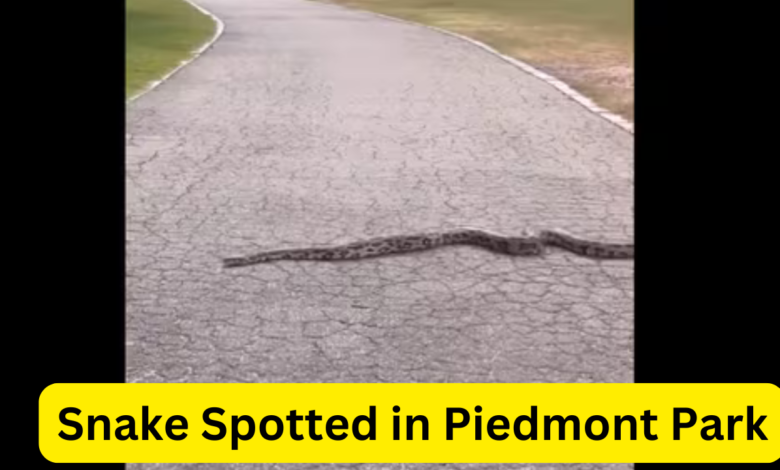Snake Spotted in Piedmont Park

Snake Spotted in Piedmont Park, Piedmont Park, nestled in the heart of Atlanta, is celebrated for its lush landscapes, serene walkways, and vibrant community atmosphere. Recently, however, the park has become the center of attention for a different reason—large snakes have been spotted slithering through the park, causing concern among visitors and locals alike. In this article, we will explore the details of these sightings, the species involved, and the broader implications for both the park’s ecosystem and public safety.
The Growing Presence of Snakes in Urban Spaces
Urban environments, including Atlanta, are witnessing an increasing trend: wildlife is making its presence felt more than ever before. The sighting of large snakes in Piedmont Park is not an isolated event but part of a broader phenomenon where wildlife is adapting to urban settings. These snakes, though non-venomous, are significant in size, making them particularly noticeable and, for some, intimidating.
Identifying the Snakes of Piedmont Park
The snakes that have been spotted in Piedmont Park are predominantly rat snakes. These snakes are common in the southeastern United States and are known for their role in controlling the rodent population. Rat snakes are non-venomous constrictors that can grow to impressive lengths, sometimes reaching up to 7 feet. Their presence in an urban park like Piedmont Park is a natural occurrence, albeit one that has drawn considerable attention.
Rat snakes are characterized by their long, slender bodies, typically black or dark brown in color with lighter undersides. They possess a distinctive wedge-shaped head and large, round pupils—features that help differentiate them from venomous snakes like copperheads or rattlesnakes. Understanding these characteristics can help park visitors identify these snakes and reduce unnecessary fear.
Why Are Snakes More Visible in Piedmont Park?
Several factors contribute to the increased visibility of snakes in Piedmont Park. Firstly, the park’s thriving ecosystem provides a rich food supply for these reptiles, making it an attractive habitat. Secondly, urban development around the park has led to the displacement of various animals, pushing them into the park’s greener pastures.
Seasonal behavior also plays a crucial role. During warmer months, snakes are more active as they hunt for food or seek mates. The overlapping of their natural habitat with the park’s environment leads to more frequent sightings during these periods.
Public Reaction and Safety Concerns
The public reaction to the snake sightings in Piedmont Park has been mixed. While some visitors are intrigued by the presence of these large reptiles, others are understandably alarmed. The sight of a 7-foot snake can be unsettling, particularly for those unfamiliar with the species or their ecological role.
In response to these concerns, public awareness campaigns have been initiated to educate visitors about the nature of these snakes. The aim is to reduce fear and promote coexistence, as these snakes play a vital role in maintaining the park’s ecological balance.
Safety Tips for Park Visitors
For those frequenting Piedmont Park, encountering a snake does not need to be a cause for alarm. Here are some important safety tips:
- Do not panic: Rat snakes are non-aggressive and pose no direct threat to humans unless provoked. If you encounter one, remain calm and give it plenty of space.
- Avoid disturbing the snake: These reptiles prefer to be left alone and will usually move away from humans if given the opportunity.
- Keep pets on a leash: Curious pets may provoke a defensive response from the snake, so it’s best to keep them under close supervision.
- Report sightings: If you spot a snake in a high-traffic area, notify park authorities. They can assess the situation and, if necessary, relocate the animal to a safer location.
The Role of the Piedmont Park Conservancy
The Piedmont Park Conservancy is actively involved in monitoring and managing the snake population within the park. Working closely with local wildlife experts, the conservancy ensures that the snakes do not pose a significant threat to visitors. Additionally, they are providing educational resources to help the public understand the importance of these reptiles in maintaining the park’s ecosystem.
Environmental Impact of Snake Populations
The presence of large snakes in Piedmont Park is not only natural but also beneficial for the environment. These snakes help control the populations of rodents and other small mammals, which can become pests if left unchecked. By keeping these populations in balance, the snakes contribute to the overall health of the park’s ecosystem.
Moreover, the presence of such predators is an indicator of a healthy environment. A thriving snake population suggests that the park is supporting a diverse range of wildlife, which is essential for maintaining ecological equilibrium.
Understanding the Ecological Role of Snakes
It’s crucial to recognize that snakes are an integral part of the park’s ecosystem. They play a pivotal role in controlling the population of small mammals, which, if left unchecked, could lead to an imbalance in the ecosystem. By preying on these animals, snakes help maintain the health and stability of the environment.
Furthermore, the presence of snakes can also be beneficial for other species. For example, by controlling the rodent population, snakes indirectly protect plant life and reduce the risk of disease transmission. This interdependence highlights the importance of preserving snake populations within urban parks like Piedmont Park.
How to Coexist with Snakes in Urban Parks
As urban environments continue to expand, interactions between humans and wildlife will inevitably increase. It’s essential for city planners, conservationists, and the public to work together to create spaces where both humans and wildlife can coexist peacefully.
Education plays a key role in this process. By understanding the behavior and ecological role of snakes, park visitors can learn to appreciate their presence rather than fear it. Public awareness campaigns, coupled with clear guidelines for safely interacting with wildlife, can help foster a more harmonious relationship between humans and nature.
Looking Ahead: The Future of Wildlife in Urban Parks
The sightings of large snakes in Piedmont Park serve as a reminder of the ongoing interaction between urban development and wildlife. As cities continue to grow, these interactions are likely to become more frequent. It’s imperative that we find ways to coexist with the wildlife that shares our urban spaces.
The future of wildlife in urban parks depends on our ability to adapt to these changes. By promoting conservation efforts, enhancing public education, and fostering a greater understanding of the natural world, we can ensure that parks like Piedmont Park remain safe, vibrant spaces for both humans and wildlife.
Conclusion: Embracing Nature in Piedmont Park
The presence of large snakes in Piedmont Park is a testament to the park’s rich biodiversity. While these reptiles may seem intimidating, they are an essential part of the park’s ecosystem, contributing to its health and balance. By learning to coexist with these creatures, we can continue to enjoy the beauty and tranquility of Piedmont Park while ensuring that it remains a safe environment for all.





One Comment